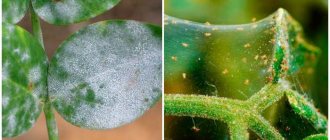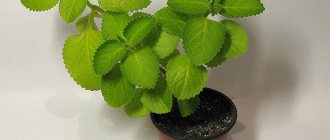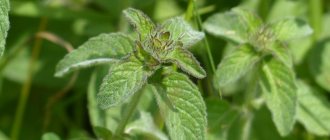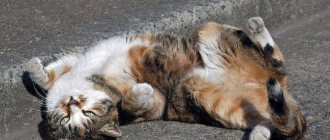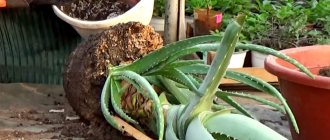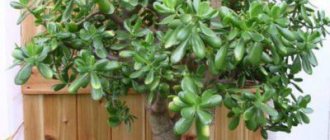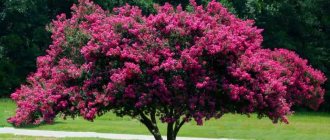The beneficial properties of mint are widely used in cooking, folk medicine and home cosmetics. It is added to salads, baked goods, and hot dishes; Soothing tea, infusions and decoctions are prepared from it to treat many diseases. Masks and lotions with menthol improve skin quality and stop age-related changes. The vitamin and mineral composition of the fresh plant is richer, and its properties are more pronounced. In order not to wait for a new harvest, mint can be grown on your windowsill and used all year round.
Varieties
Plectranthus shrubby
Capable of growing to impressive sizes. Its monochromatic leaves are heart-shaped. The main feature of the plant is the subtle aroma of essential oil.
If you mash the leaf, the smell becomes much more intense. This pleasant smell repels insects, including house moths. Therefore, plectranthus fruticosa is often called the moth tree.
Ernst caudex
It looks like a tree; the plant accumulates moisture in the lower part of the trunk.
Felt
It is also an unpretentious plant; it can be grown with equal success both indoors and outdoors. Of course, it grows much taller outdoors than indoors. The appearance is ampelous, the cascading branches and leaves smell of mint. At home, felt mint grows very slowly and does not reach large sizes.
Ertendaal variety
It is considered perhaps the most beautiful view. It has unusual carved leaves that have different colors. Their upper part is green and the lower part is purple-pink.
The top surface of the leaves is velvety with thin light veins. In addition to this, they smell pleasantly of camphor oil. This variety is the most popular among gardeners.
Plectranthus whorled
Similar to the Ertendahl variety, it can often be seen on window sills.
Plectranthus coleus
It also has very peculiar variegated leaves. They are large, bordered with a cream or white stripe. The stems grow strictly vertically.
Hybrid Mona Lavender
Perhaps the most extravagant look. It begins to bloom in early September. How does plectranthus bloom? Very long and dense inflorescences of bluish-violet tubular flowers form on its straight stems.
There are blue specks on the surface of the petals. The stems themselves are brown in color. The leaves of this hybrid are large and oval in shape. On the lower surface of each leaf there is a purple fluff, and the upper surface is glossy.
— The Madagascar variety is beautiful.
Description of indoor mint or plectranthus
Plectranthus, spur flower or indoor mint (Plectranthus), is a perennial plant of the Lamiaceae family. It has straight or creeping tetrahedral shoots with or without pubescence. The leaves of indoor mint are opposite, on petioles, ovoid or round in shape, wavy-crenate along the edge. The plates can be either bare or pubescent, but in any case their characteristic feature is a pleasant aroma.
In spring, small purple, pink or white buds appear on the shoots of plectranthus, collected in whorls. They do not have any particular decorative value, so when grown indoors they are often removed immediately after their appearance. The spur flower looks attractive even without buds due to its beautiful leaf blades.
Indoor mint reaches a height of 0.3-1.5 m
Plectranthus grows naturally in tropical and subtropical regions. It is found in southern Africa and on the island of Madagascar, on the Pacific coast, in the northern part of Australia, in Asia and India. The plant is grown artificially in temperate climates and even in the north.
Useful properties of homemade mint
It is absolutely certain that indoor mint plectranthus has very diverse beneficial properties. The leaves, stems and flowers of plectranthus are saturated with fragrant essential oils. Their smell repels insects, including house moths. If this flower grows in the room, then this insect will never appear in woolen carpets. You can also protect clothes in your wardrobe from moths by placing a small bag of dried flowers or plant leaves in it.
But is it possible to eat plectranthus? Yes, the leaves and flowers of the plant can be used in cooking as a natural flavoring. Add them to any dishes, marinades, sauces, drinks. This will only make their taste more pleasant. In addition, different types smell differently. Some smell like mint, others smell like thyme or smell like oregano.
Plectranthus mint also has a number of medicinal properties that have long been used in folk medicine. Is it possible to brew leaves? Need to! Tinctures, decoctions and aromatic teas made from peppermint are an excellent sedative.
If you apply a compress of these remedies to your temples, the headache quickly goes away. The juice of the leaves heals the throat, promotes rapid healing of wounds and insect bites. Tinctures and decoctions of this plant quickly suppress any inflammation in the oral cavity.
You can add a decoction of plectranthus flowers and leaves to water and take restorative baths. The plant is also used in the preparation of cough medicines and diuretics.
How to use homemade mint in folk medicine
The use of fragrant spur flower is practiced in home medicine. The anti-inflammatory, analgesic and strengthening properties of the plant have a positive effect on the body for many ailments.
For enuresis
The benefits and harms of decorative indoor mint allow the plant to be used for enuresis in children and adults. An infusion is prepared based on the spur flower, which is then added to healing baths. The algorithm looks like this:
- Dry or fresh plectranthus leaves are crushed in the volume of a glass.
- Pour the raw material with 500 ml of hot water.
- Leave covered for 45 minutes.
- Strain and pour the product into a filled bathing container.
It is necessary to take such a bath for half an hour shortly before bedtime. The water temperature should only be about 30 °C. Baths are taken daily or every other day until the condition improves. The procedures not only help get rid of enuresis, but also increase skin tone.
The infusion of indoor mint does not last long, so it should be prepared anew every day.
When coughing
The healing properties of aromatic plectranthus improve expectoration during colds and help relieve coughs. Traditional medicine recommends preparing the following remedy:
- About 10 g of dried leaves of the plant are poured into the teapot.
- Pour 300 ml of hot liquid into the raw material.
- Cover with a lid and leave for 15 minutes to infuse.
- Strain through a strainer and pour into cups.
You can drink medicinal tea 2-3 times a day on a full stomach.
Advice! If desired, plectranthus leaves can be mixed in equal volumes with regular tea leaves.
For psoriasis
Indoor mint copes well with skin irritations and has a beneficial effect on psoriasis, eczema and other diseases. It is recommended to use a simple infusion of an ornamental plant. They do it like this:
- Grind clean fresh leaves in the volume of half a glass.
- Brew the raw material in 1 liter of boiling water.
- Leave the infusion in a closed container for a couple of hours.
- After time, filter.
In the finished product, you need to moisten a clean cloth or gauze and treat the affected areas of the skin. It is allowed to wipe the epidermis 4-5 times a day. The infusion has a good effect on diaper rash in children and bedsores in the elderly.
For insect bites
Itching, burning and pain from insect bites are well relieved by fresh plectranthus juice. The plant is used as follows:
- Several leaf blades of the spur flower are thoroughly ground to a paste.
- Squeeze the raw material through cheesecloth to obtain pure juice.
- Soak a cotton pad in the liquid.
We recommend reading: Crescent: beneficial properties and contraindications, recipes
The juice is applied to the bite sites several times a day. The product can also be used to wipe inflamed wounds and cuts.
Transfer
After purchasing a plectranthus, be sure to transplant it into a new, larger pot. Carefully remove the plant from the store container without destroying the earthen ball, place it in a new pot and add soil.
In the future, the plant will be replanted annually for at least five years. Replant in early spring. Replant an adult plant as needed, when it becomes crowded in the pot. Adult mint bushes can be transplanted into open ground for the summer. Be sure to return it indoors before the first frost.
It is advisable to grow Plectranthus in soil, the composition of which you prepare yourself. To do this, take two parts of turf soil, one part of humus and leaf soil, and half of each sand and peat. Mix all these components thoroughly until a homogeneous mass is obtained. The resulting soil should be moderately loose.
Feed homemade mint only during the period of active growth and flowering once a month, not more often. In winter it does not need feeding. Moreover, it is harmful to the plant. Fertilize the soil alternately with organic fertilizers and mineral fertilizers.
Caring for plectranthus at home
Organizing care for plectranthus is quite simple. You need to adhere to a few basic growing rules.
Microclimate
Homemade mint prefers moderate temperatures. In the summer, it will feel comfortable at 22 °C, and in winter it is advisable to reduce the temperature to 15 °C.
Watering rules
Most varieties of indoor mint prefer abundant watering and spraying. Plectranthus tolerates short drought well, but when the soil regularly dries out, it begins to wither. In winter, it is recommended to reduce watering to moderate levels so that the plant can go into a dormant state.
Top dressing
It is recommended to feed mint plectranthus in spring and summer - complex mineral fertilizers in liquid form are added to the soil every 2 weeks. In winter, fertilizing can be stopped, but if the temperature in the room remains at 20 ° C with sufficient lighting, then it is still allowed to apply fertilizer - no more than once a month.
Watering and air humidity
Mint grows quickly and pleases with large flowers. For this, the plant, especially the flowering one, requires a lot of moisture. In the period from early spring to mid-autumn, water it often, abundantly, without allowing the top layer of soil in the pot to dry out.
It should be said that the flower, especially the caudex type, is able to survive short-term drought even if the entire earthen clod dries out completely. However, it is not worth bringing it to this point.
On the contrary, during active growth, along with abundant watering, be sure to spray the plant with warm water at least once a day. With the onset of cold weather, reduce watering to a minimum, since at this time the plant is half asleep.
Planting and care
We recommend planting homemade mint from cuttings.
Choose thicker, healthier cuttings. This will allow the plant to grow faster. Purchase suitable soil from a flower shop and dilute with regular soil. Make a small depression in the selected container and fill it with water. Lower the cutting and bury it. Press lightly on top with your palm. Pour warm water at room temperature. After three days, water again. Place the container on the eastern windowsill. The room temperature should not exceed + 25 degrees. In winter, not lower than +12 degrees.
Water abundantly as the soil dries. We recommend pruning bare shoots in early spring or late autumn. Cutting to half the stem. This will allow you to have strong and healthy leaves. Pinching out young shoots. The bushes will look beautiful.
Lighting, temperature
Plectranthus requires bright but diffused light. But don't leave it under the scorching rays of the sun. If you definitely want to place a pot with this flower on the windowsill on the south side of the room, then be sure to protect the plant with a screen. During short daylight hours, illuminate the bush with a neon lamp
In nature, mint grows in the shade of tropical trees, where the air temperature is low. Domestic varieties also require moderate ambient temperatures ranging from 20 to 22 degrees.
That is, at room temperature the plant feels most comfortable. At an ambient temperature of 15 degrees, leaves begin to fall. If you do not move the flower to a warmer place, it will soon die.
What does Plectranthus look like, what family does it belong to?
Plectranthus (mint) belongs to the category of herbaceous plants or evergreen shrubs, the height of which does not exceed 65-80 cm. The shoots of the crop are branched. They can not only grow upward, but also spread along the surface of the soil. The fibrous type of root system is not located deep enough. Ribbed shrubby stems may be bare or pubescent depending on the variety.
Flowering indoor mint
On a note! The skin of the stem part is colored green or brown-red.
The leaf blades are arranged crosswise on short petioles, in pairs. The ovoid foliage is fleshy. Its outer parts are covered with small teeth. On the surface of the green mass you can see veins or a variegated pattern. The green mass contains aromatic glands, thanks to which the variegated plectranthus emits an amazing smell, which may contain spicy or minty notes.
You can admire the blooms in the summer months. The paniculate inflorescences are quite dense. They are located at the tips of the branches. Flowers of both sexes consist of 5 petals, fused at the base into a tube. The two-lipped corollas are painted in a different palette:
- white;
- lilac;
- blue;
- lavender;
- purple.
In the central part there are miniature stamens and an ovary. After the plectranthus has been pollinated, the process of ripening of the fleshy fruits begins. There are 4 nuts in the inner part of the fruit. After ripening, the fruits open on their own. Growing and caring for mint is quite simple, the main thing is to follow the recommendations of experts in the field of floriculture.
Coleus variety
Popular varieties
There are more than 250 varieties of indoor mint. Some of them are completely different in appearance from mint. The most popular types:
- Plectranthus coleoide belongs to the category of shrubs with erect shoots. The height of the plant can reach 95-100 cm. The surface of the ovoid foliage is shiny. Mint shoots are tetrahedral. The soft petioles and the stem part are pubescent. The leaf blades are painted in a rich green palette. On the surface of the green mass you can see white spots or stripes along the edges.
- Plectranthus Ertendahl (oertendahlii) is a herbaceous perennial crop whose shoots spread along the surface of the soil. The height of the bushes reaches 40 cm. Ampelous plectranthus is distinguished by petiolate opposite foliage, the length of which is within 6 cm. On the surface of the green mass you can see silvery patterns that are located along the veins. The lower part of the foliage is covered with red fibers. In the summer, racemose inflorescences, the length of which does not exceed 30 cm, begin to bloom on the upper parts of the shoots. Each of the bells is painted in soft lilac tones or a white palette.
- Plectranthus Mona Lavender is a hybrid variety of upright shrubs whose stems are covered with brown-brown skin. The ovoid foliage is green. The surface of the jagged green mass is glossy. The reverse side of the foliage is covered with purple fibers. On flowers of a violet-blue tone you can see blue dots. During the flowering period, indoor plectranthus acquires an attractive appearance.
Ertendaal variety
- Plectranthus oakleaf is a plant with fleshy, erect stems covered with serrated and leathery foliage, the shape of which resembles the outlines of oak leaves. The green mass is colored in a dark green palette and covered with short silvery fibers. By rubbing the leaves between your fingers, you can feel a pleasant, pronounced pine aroma. Caring for plectranthus is quite simple, so even beginners in the field of floriculture can grow it.
- Plectranthus tomentosa belongs to the category of miniature bushes, the carved foliage of which is densely pubescent and painted in a light green palette. Drooping shoots. A pleasant mint aroma emanates from the foliage. The plant needs good lighting and systematic watering with settled rainwater.
- Southern plectranthus is an evergreen perennial that belongs to the category of herbaceous plants. Indoor mint can spread along the surface of the soil and thereby form a continuous large carpet. Burgundy stems, when grown in pots, hang down in a chic cascade. Glossy, round-shaped foliage is painted in a green palette. The edges of the green mass are jagged. Numerous branched veins can be seen on the surface of the leaves. The flower stalks are quite tall and leafless. Floriculture experts often call the southern variety Swedish ivy.
- Plectranthus variegata is a variety of indoor mint, the leaf blades of which are painted in a gray-green palette. The outer parts of each sheet are painted in light colors. During flowering, small white flowers form on the bushes. The variegated variety looks good when grown together with pelargonium and surfinia, barbatus and golden mint.
Note! No less popular are such types of plectranthus as Nico and plectranthus Ruffle.
Medicinal properties
Homemade mint (plectranthus) – can it be consumed? Fragrant plectranthus is naturally endowed with beneficial properties. With the help of tea prepared from indoor mint, you can cure colds, fever, and disorders of the gastrointestinal tract. The plant helps cope with irritable bowel syndrome.
Infusions containing plectranthus flower have a strong calming effect, which has a positive effect on the nervous system. People suffering from frequent nervous tension, anxiety and insomnia should drink an infusion containing mint every evening before bed. In addition, plectranthus is naturally endowed with choleretic properties and an expectorant effect.
Pruning, propagation
Trim the stems in early spring. In this case, it is advisable to trim weak stems to half their length. Strong stems should not be cut; it is better to pinch them. By the way, you can pinch the stems at any time of the year. This will make the bush plectranthus thicker.
The easiest way to propagate is by cuttings. The root panicle on cuttings of homemade mint forms very quickly; after just a couple of weeks they are ready for planting in separate pots.
In this case, cuttings germinate equally quickly both in water and in wet sand or waterlogged soil. It is allowed to plant several cuttings in one pot at once. This is done to obtain a very lush bush.
Preparation of raw materials from plectranthus
The raw material for the preparation is the leaf-covered tops of aromatic plectranthus. Medicinal raw materials of plectranthus are harvested before and during the active flowering phase, which is when the saturation of the plant with beneficial substances is highest.
Harvesting should be done on fine, dry days, when the leaves are protected from moisture. The tops are cut off with scissors and dried in the shade, since exposure to the sun is detrimental to the substances in the leaves and promotes the release of essential oils.
However, you cannot dry the plectranthus in dryers, ovens, or stoves - the plectranthus will lose all vitamins and minerals.
If the plant is dried correctly, it retains a very noticeable aroma.
Diseases and pests
Indoor mint is deservedly considered an unpretentious plant; with careful care it never gets sick and is not exposed to harmful insects and microorganisms. Improper care for it leads to sad consequences.
- Most often, problems arise due to excessive watering. As a result, the roots of the plant begin to rot, and the leaves begin to turn yellow and fall off. Even worse, it can cause powdery mildew on the leaves. It appears as gray spots. In such cases, sharply reduce watering and remove powdery mildew colonies from the leaves. This can be done using a soap solution or special chemicals. A solution of serum in water quite effectively cleans leaves of powdery mildew. It should contain one part whey and three parts water.
- A prolonged lack of moisture in the soil also leads to trouble. In this case, the plant begins to wither. Keep in mind that if you repeatedly bring the plectranthus to this state, then eventually resuming normal watering will no longer lead to a positive result, the plant will still die.
- In direct sunlight, the leaves fade and the mint loses its attractiveness.
If the air in the room where the plectranthus grows is too dry, and you forget to spray the plant, then it will soon become infected with spider mites, aphids or scale insects. You can only get rid of these parasites using chemicals. A soap solution will not help because the leaves are fluffy - they cannot be washed.
Contraindications and side effects during use
Although the plant has a wide range of uses, there are also contraindications to taking plectranthus. It is forbidden to take it by pregnant and breastfeeding women, as well as by children under 12 years of age.
If some people have sensitive skin, contact with the leaves and stems of peppermint will cause mild dermatitis. Allergies and individual intolerance are the main contraindications.
In case of hypotension, aromatic plectranthus will also cause harm: it can reduce blood pressure to critical levels. It is not recommended for use by people with varicose veins.
You should also limit your consumption of spur flowers, do not take them too often - it can cause heartburn if overused.
Thus, plectranthus can provide assistance in various aspects of human life, from medicinal to culinary, and esotericists believe that with its beautiful aesthetic appearance it will attract fun and good luck into the house in all life endeavors.
Signs
Popular rumor ascribes to plectranthus the same properties as the money tree. That is, it supposedly helps improve the financial situation of the family. Of course, there is no scientific evidence for this yet. However, in Scandinavian countries this plant can be seen in every home.
Signs and superstitions say that mint promotes good relationships in the family, if not to say that it is a family peacemaker. Many claim that mint strengthens sleep and relieves household members of bad thoughts.
Olga Danilina
Pain
The refreshing aroma of mint is also a quick and effective remedy for nausea and headaches. To enhance the effect, you can rub aromatic peppermint oil on the forehead.
Mint will also help cope with muscle pain. To relax your muscles, mix a cup of sea salt, a third of a cup of olive oil and 6-8 drops of peppermint essential oil. Massage your feet for 5-10 minutes and rinse off.
A close encounter with an exotic plant
Plectranthus aromatica is a perennial herbaceous plant of a ground cover or climbing nature. It has thin stems covered with small, fleshy leaves. The plates are painted bright green and slightly pubescent. Some species have a white border near the carved edges of the foliage. The flower has a pleasant aroma that resembles mint or cut meadow grass.
During flowering, miniature bell-shaped buds of the following colors are formed on the plectranthus:
- pink;
- white;
- lilac;
- purple.
They are collected in raceme inflorescences, which look original among the lush greenery.
To prepare medicinal raw materials, the tops of the shoots, which have several leaves, are plucked off. This is best done during dry periods when there is no moisture on the plant.
